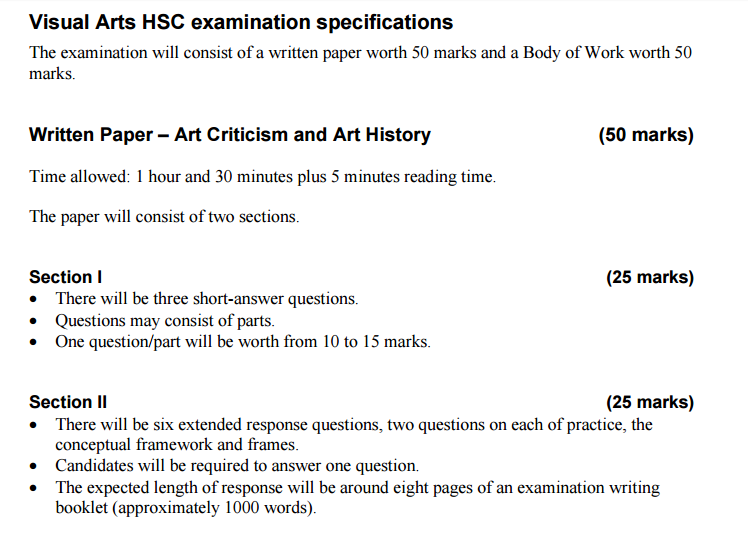When it comes to art, it can be unclear exactly what is involved in your HSC Visual Arts assessments.
Since reading a 40 page syllabus can feel daunting, we’ve done all the hard work for you and put together a guide covering all the elements of the HSC Visual Arts Assessments!
The Overall Breakup
School-Based Visual Arts Assessments:
- Development of the body of work (50%)
- Art criticism and art history (50%)
External Examination:
- Submission of a body of work (50%)
- Written paper (50%)
Note: The School based assessments and the external exam make up half of your mark each, but your performance and your school’s performance in the external examination will affect the scaling of your school marks.
Now, let’s look at the requirements for each of these assessments in more depth, so we know exactly what we’re doing.
School-Based Visual Arts Assessments
1. Development of the Body of Work (50%)
The marking of your body of work throughout the year falls on two main criteria:
- Conceptual strength and meaning:
- Resolution: The level of skill in artmaking that the artwork shows
The art making practice is all about practically applying your theoretical knowledge of the frames.
In school, you’ll be assessed on how well you reflect each of the frames below.
| Type of frame | Definition |
|---|---|
| Conceptual framework | The way your artwork explores the interaction between artists, artworks, audiences and the world |
| The Structural Frame | The visual signs and symbols which represent your idea |
| The Cultural Frame | How your artwork explores the values and ideas of your own or other’s cultures |
| The Subjective Frame | The way you express your own deep emotions, your imaginative portrayal of subject matter, and how you evoke emotion from your audience |
| Postmodern Frame | Your ability to challenge artistic conventions, traditions and the definition of art |
The structure of your school assessments will look something like this:
| Assessment | Requirement |
|---|---|
| Proposal | An interview or written piece which explains your inspiration, goals and plan of action for your major work |
| Visual arts process diary | Your visual arts process diary is a place for you to record your development of ideas, reflect on and evaluate your major work, and practice refinement of your artmaking skills |
| Art-making process marked throughout year | At different points in the year, your school will have expected you to have completed a certain amount of your major work. You will be marked on the development of your concept, your refinement of artmaking skills and the amount you have completed |
The NESA assessment and Reporting guide explains that schools are to use their own discretion in choosing assessments, and 3-5 assessments are sufficient (including assessments on art criticism and art history).
We’ve written an article to help if you’re looking for inspiration for the HSC Visual Arts Major work!
2. Art Criticism and Art History (50%)
Throughout the year, you will be assessed on your understanding of art criticism and art history.
Your assessments may include in class responses to questions, or take-home essays.
These Visual Arts assessments will be based on the following:
Practice, Conceptual Framework and the Frames
For your Visual Arts assessments, you will be judged on your understanding of Practice, Conceptual Framework and the Frames, and how they interact with one another.
The questions asked in exams, short answers and essays will test your knowledge on these three components.
For a more in depth explanation of the conceptual framework and the Frames, have a look through here!
Investigation of Content Through at Least 5 Case Studies in Art Criticism and Art History
This section of assessment is entirely dependent on your school, and what they choose to teach, so we can’t tell you what to expect! Your teachers will choose a selection of artists art critics, historians and/or art movements.
You will learn about these case studies by applying Practice, the Conceptual Framework and the Frames.
External Examinations
1. Submission of a Body of Work (50%)
Once again, the two defining factors in your body of work are your conceptual strength & meaning, and your resolution. Below are the syllabus outcomes.
Art-making outcomes:
- Practice: initiates and organises artmaking practice that is sustained, reflective and adapted to suit particular conditions
- Conceptual framework: applies their understanding of the relationships among the artist, artwork, world and audience through the making of a body of work
- Frames: demonstrates an understanding of the frames when working independently in the making of art
- Representation: selects and develops subject matter and forms in particular ways as representations in art-making
- Conceptual strength and meaning: demonstrates conceptual strength in the production of a body of work that exhibits coherence and may be interpreted in a range of ways
- Resolution: demonstrates technical accomplishment, refinement and sensitivity appropriate to the artistic intentions within a body of work
2. Written Paper (50%)
And finally you will be assessed during the HSC examination period with a mixture of short answer questions and a long answer response.
In this section, you will be using your knowledge of practice, the frames and conceptual framework as well as your five case studies to answer the questions.
Check out our Band 6 Essay Scaffold for HSC Visual Arts to get a glimpse of what’s expected out of your extended responses! Scaffolding is a great way to approach your assessments for this unit so that you can organise information on your artists and artworks in a clear structure.
That’s all for HSC Visual Arts Assessments. Good luck!
Looking for extra help with HSC Visual Arts?
We pride ourselves on our inspirational HSC Visual Arts coaches and mentors!
We offer tutoring and mentoring for Years K-12 in a variety of subjects, with personalised lessons conducted one-on-one in your home or at our state of the art campus in Hornsby!
To find out more and get started with an inspirational tutor and mentor get in touch today!
Give us a ring on 1300 267 888, email us at [email protected] or check us out on TikTok!
Brooklyn Arnot is currently studying Philosophy, History and English at The University of Sydney. In her spare time she enjoys drawing mythical landscapes, flowers, trees, and artsy signs for her cafe during long train rides and basically any time there is a pen and paper around. Her incredible high school English teachers gave her a passion for literature and education, leading to her extreme enthusiasm for the HSC English syllabus and her dream to go to Scandinavia to study old viking literature.







